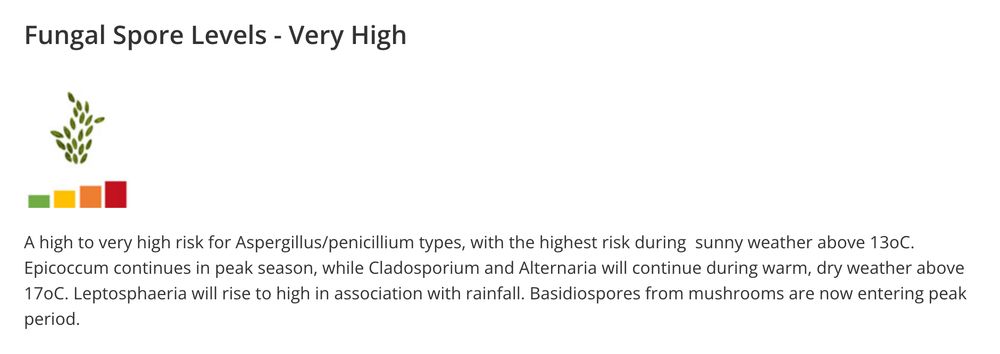#Aspergillus
#Penicillium
#Eurotiales
#Classification
#extrolites
www.studiesinmycology.org/sim/Sim112/S...
#Aspergillus
#Penicillium
#Eurotiales
#Classification
#extrolites
www.studiesinmycology.org/sim/Sim112/S...
From chaos to tranquillity: a modern approach to the identification, nomenclature and phylogeny of Aspergillus, Penicillium and other Eurotiales, including an updated accepted species list
From chaos to tranquillity: a modern approach to the identification, nomenclature and phylogeny of Aspergillus, Penicillium and other Eurotiales, including an updated accepted species list

www.worcester.ac.uk/about/academ...

www.worcester.ac.uk/about/academ...


Des champignons comme Aspergillus ou Penicillium produisent des conidies, spores microscopiques très légères, qui se retrouvent partout dans l’air et peuvent être inhalées.
3/6
Des champignons comme Aspergillus ou Penicillium produisent des conidies, spores microscopiques très légères, qui se retrouvent partout dans l’air et peuvent être inhalées.
3/6

''Εκτεταμένη παρουσία παθογόνων μυκήτων(Aspergillus fumigatus,Aspergillus niger, Aspergillus flavus,Penicillium spp.,Rhizopus arrhizus) σε χειρουργεία, διαδρόμους & κλινικές. Οι χώροι κατατάσσονται σε κατηγορία υψηλού κινδύνου...''
www.rosa.gr/koinonia/yge...

''Εκτεταμένη παρουσία παθογόνων μυκήτων(Aspergillus fumigatus,Aspergillus niger, Aspergillus flavus,Penicillium spp.,Rhizopus arrhizus) σε χειρουργεία, διαδρόμους & κλινικές. Οι χώροι κατατάσσονται σε κατηγορία υψηλού κινδύνου...''
www.rosa.gr/koinonia/yge...
In fact, some are used to make foods or medications, e.g., penicillin.
The 4 most common mycotoxins to humans are:
- ASPERGILLUS (grows on grains)
- PENICILLIUM (on rotting fruits)
- FUSARIUM
- TACHYBOTRYS (black mold)
rxhometest.com/product/myco...

In fact, some are used to make foods or medications, e.g., penicillin.
The 4 most common mycotoxins to humans are:
- ASPERGILLUS (grows on grains)
- PENICILLIUM (on rotting fruits)
- FUSARIUM
- TACHYBOTRYS (black mold)
rxhometest.com/product/myco...
📅 October 6–8, 2025 (3 days)
Learn to identify fungi found in food and indoor environments through hands-on training with over 70 species, including Aspergillus, Penicillium, Fusarium, and more.
📅 October 6–8, 2025 (3 days)
Learn to identify fungi found in food and indoor environments through hands-on training with over 70 species, including Aspergillus, Penicillium, Fusarium, and more.
📅 October 6–8, 2025 (3 days)
Learn to identify fungi found in food and indoor environments through hands-on training with over 70 species, including Aspergillus, Penicillium, Fusarium, and more.
📅 October 6–8, 2025 (3 days)
Learn to identify fungi found in food and indoor environments through hands-on training with over 70 species, including Aspergillus, Penicillium, Fusarium, and more.

🔗 doi.org/10.1093/gbe/evaf125
#genome #evolution #TEsky

🔗 doi.org/10.1093/gbe/evaf125
#genome #evolution #TEsky
📆October 6–8 (3 days)
This course focuses on the phenotypic identification of fungi commonly found in food products and indoor environments. Participants will receive hands-on training with over 70 species from genera including Aspergillus, Penicillium, & Fusarium.
2/5
📆October 6–8 (3 days)
This course focuses on the phenotypic identification of fungi commonly found in food products and indoor environments. Participants will receive hands-on training with over 70 species from genera including Aspergillus, Penicillium, & Fusarium.
2/5
Available digitally in the LDC online fair until July 31!!




Available digitally in the LDC online fair until July 31!!
Leggi qui l'articolo di @giuliacrepaldi89.bsky.social 👇
ilfattoalimentare.it/richiamo-caf...

"Bacillus cereus, B. subtilis, Staphylococcus aureus, S. epidermidis, Enterobacter aerogenes, Serratia marcescens, Candida tropicalis, Lodderromyces elongisporus, Aspergillus aculeatus and Penicillium citrinum."

"Bacillus cereus, B. subtilis, Staphylococcus aureus, S. epidermidis, Enterobacter aerogenes, Serratia marcescens, Candida tropicalis, Lodderromyces elongisporus, Aspergillus aculeatus and Penicillium citrinum."
📅 October 6–8, 2025 (3 days)
Learn to identify fungi found in food and indoor environments through hands-on training with over 70 species, including Aspergillus, Penicillium, Fusarium, and more.
📅 October 6–8, 2025 (3 days)
Learn to identify fungi found in food and indoor environments through hands-on training with over 70 species, including Aspergillus, Penicillium, Fusarium, and more.
📆 October 6–8, 2025
This course focuses on the phenotypic identification of fungi commonly found in food products and indoor environments. Participants will receive hands-on training with over 70 species from genera including Aspergillus, Penicillium, Fusarium, and others.
📆 October 6–8, 2025
This course focuses on the phenotypic identification of fungi commonly found in food products and indoor environments. Participants will receive hands-on training with over 70 species from genera including Aspergillus, Penicillium, Fusarium, and others.

